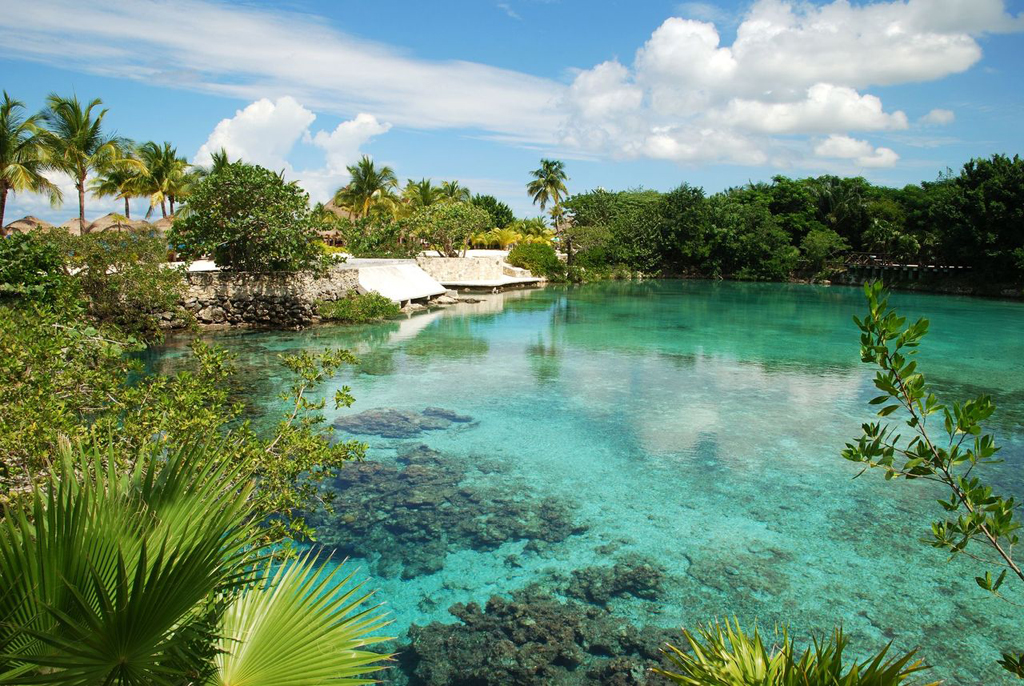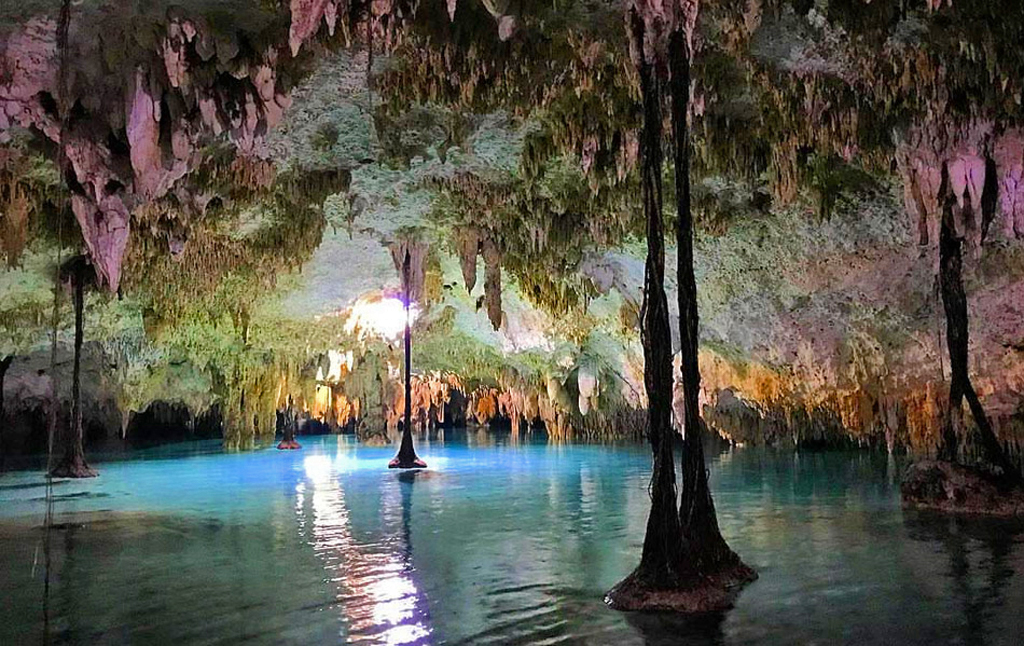
Cenote diving is one of life's great adventures, and Mexico's Yucatan peninsula is the best place on earth to experience the magic and mystery of these sparkling natural pools. Fed by steady flows of crystal-clear fresh water, cenotes attract everyone from snorkelers to cave divers.
What are cenotes? The name comes from the Mayan word tsʼonot, which describes a natural pool of groundwater, some of which were revered as sacred wells. According to Mayan mythology, these pools were portals into the water-filled underworld known as Xibalba. Today, we know that cenotes are the collapsed ceilings of tunnels that have become windows into a vast network of underground rivers flowing through the Yucatan's limestone substrate. Cave divers have mapped hundreds of miles of these flooded passageways, and photographers have captured the splendor of submerged chambers decorated in stunning displays of bone-white stalagmites and stalactites. But you don't have to be an intrepid explorer to dive a cenote. Shadowy overhangs and half-filled chamber give intriguing glimpses of the underworld; the open water portions of these pools are inviting, light-filled realms that can be enjoined by all; and the underground rivers that feed cenotes emerge near the coast as sparkling lagoons.
COASTAL DELIGHTS
Like all rivers, the Yucatan's underground waterways flow to the sea. This meeting of the waters often takes place in mangrove-shrouded lagoons where freshwater and salt mingle to create a vibrant habitat for tropical fish and other marine life. Because these lagoons are filled with clear water, of moderate depth and flooded with sunshine, scuba gear and dive lights are unnecessary. Instead, they are best enjoyed with mask and snorkel.

One of the best-known and most popular snorkeling sites in the Yucatan is Xel-Há. This expansive lagoon is now operated by the Xcaret ecological park, and billed as an all-inclusive park that includes additional activities such as zip-lining, jungle hikes, mangrove tubing, water slides, lunch and more. For some, these added attractions and amenities add to the appeal, making Xel-Há a fun-filled and family-friendly outing. Purists who want to focus primarily on the snorkeling experience have other options.

A few miles north of the town of Tulum, the world's longest underwater river emerges into a winding limestone channel. Long-time locals know this Cenote Manatee, so named for the namesake Sirenia that sometimes visit the site. More recently, the lagoon is referred to as Casa Cenote in reference to the beachfront hotel and restaurant located adjacent to the site. By either name, the snorkeling experience is second to none. The limestone banks of the cenote are lined with dense mats of mangroves with overhanging mats of tangled roots. Below, the walls of the waterway recede into intriguing caverns and swim-throughs. Tropical fish swirl and schools of silver-side tarpon form slow-moving patrols. An even greater variety of fish life can be found at the lagoon known as Yal Ku. Located just outside the coastal village of Akumal, this large, shallow basin opens to the sea at its far end. This allows sea turtles and tropical reef fish to enter, and creates a variety of ecosystems as the waters transition from fresh to brackish and then salt.
OPEN WATER OASES
Moving inland, there are literally thousands of cenotes hidden in the jungles of the Yucatan. In the early days of cenote diving, reaching many of these sites required a hike and a scramble down limestone bluffs to the water. Growing popularity lead some land owners to develop their waterholes, first adding ladders, docks and basic changing rooms, and more recently with full bathrooms and well-maintained roads. The price of these upgrades is relatively modest, with admission fees typically running from $5 to $10, and a bit higher for the most popular and well-developed cenotes.

Two of the most popular and largest open-water sites in the Playa del Carmen area are Cenote El Eden and Cenote Azul. Both are known for clear water and abundant fish. El Eden is also a favorite with divers and snorkelers, while Cenote Azul's moderation makes it better suited for swimmers and snorkelers. Accounts of diving in Cenote Azul are referring to a sinkhole of the same name located well to the south in the Bacalar region. For divers, “the other” Cenote Azul might be worthy of a road trip, as it is one of the deepest cenotes in Mexico, and can be explored as a guided cavern dive.
Closer to the Maya Rivera resort district is Gran Cenote, which is often considered a must-do on the cenote circuit. This site's main basin attracts everyone from snorkelers to open-water divers and cave divers in full regalia, as it is the entrance to one of the region's largest cave systems. Gran Cenote gives open water divers a taste of cavern diving, as they can safely venture beneath overhanging ledges into corners decorated with stalactites and stalagmites. The waters are crystal-clear and filled with fish, but the basin can get crowded when tour bus loads of snorkelers arrive. For more in-water elbow room, visitors can follow a series of wooden walkways that connect the main basin to a series of additional pools. In-water solitude can also be found at nearby Cenote Cawash, where a calm pool faces a cavern opening decorated with limestone pillars.

One of the most intriguing open water cenotes in the Yucatan is Angelita. Located 10 miles south of Tulum, the “little angel” is a circular pit that drops straight down to depths of nearly 200 feet. The upper half of the pit is filled with fresh water. Then, as divers reach the 100-foot mark, they encounter a cloud-like layer of hydrogen sulfide that marks the boundary with the saltwater layer below. A log-strewn debris pile rises above the aquatic mists, creating an otherworldly scene.
INTO THE SHADOWS
The big thrills of cenote diving lie in the shadows. Pools of water created when the ceilings of underground rivers collapse often feature large overhangs where sunlight from the surface penetrates deep into hidden recesses. Some of these caverns are fully flooded, while others contain air chambers. Both types provide divers with a unique opportunity to experience an underground submersion without the complications and risk of cave diving. Adding to the safety factor is a common requirement that this type of diving be done with a cenote-qualified divemaster with cavern or cave diving experience, making them

Some of the most spectacular cavern dives take place in Cenote Sak Aktun, which is part of the world's longest underwater cave system. At this site, divers can navigate through caverns half-filled with water, where openings in the ceiling let in shafts of sunlight, and dive lights are needed only to highlight the intricate bone-colored formations that give this system its name – Sak Aktun is Mayan for The White Cave.
The same underground river system that flows through Cenote Sak Aktun feeds another of the Yucatan's star cavern diving attractions. Dos Ojos, which translates to “two eyes,” is a site where two large sinkholes are connected by a 1,000-yard passage. The “wide open” eye is a pool filled with natural light that filters deep into a network of ledges and swim-throughs. Routes circumnavigating the pool and the connecting passage are well-marked with guidelines. The other eye is a semi-flooded chamber where a small chimney-like opening in the ceiling lets in a single shaft of sunlight. It is known as the Bat Cave, and divers who want to feel like Indiana Jones can begin their exploration of Dos Ojos at a surface entrance where gear is lowered on ropes while divers clamber down a suspended stairway into the shadowy pool below.

Another cavern dive at the top of the must do-list takes place at the aforementioned Cenote El Eden. After crossing the site's large open water basin, divers can descend into a large cavern where passageways lead into an extensive cave system. Open water divers can follow a very large tunnel to a second pool known as Cenote Coral, which is even larger than the entrance basin. While circling this basin, divers will encounter a unique phenomenon known as a halocline, which is the boundary layer between fresh and salt waters. Sunlight gives this border layer a mirror-like sheen when seen from above, while dropping into the mixing zone creates interplays of light and distorted vision that subside as divers move into the salt water-filled depths.
This is just a sampling of the cenote snorkeling and diving adventures that await in Mexico's Yucatan. Caradonna Adventures offers cenote and ocean diving packages with the top resorts and dive operators in the Rivera Maya. To learn more, get in touch with a Caradonna travel professional to start planning your own explorations of the Mayan's flooded underworld.